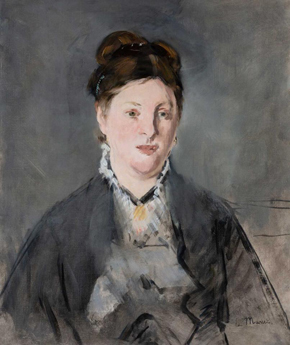11.29.23 — Meet Me at the Met
Edouard Manet and Edgar Degas met in the Louvre, and why not? How many artists today first met at a gallery—or at the Met? But of course there was more to it. There always is.
“Manet / Degas” at the Met describes an extended meeting and a falling out. It has more than enough room for both figures—their habits, their families, and their friendships as well, and it is also the subject of a longer and fuller review in my latest upload.  And then you, too, can start asking questions. Just how close were they over more than thirty years, and what took them their marvelously separate ways? What were they doing in the Louvre to start with? Degas still had trouble putting his finger on it in looking back.
And then you, too, can start asking questions. Just how close were they over more than thirty years, and what took them their marvelously separate ways? What were they doing in the Louvre to start with? Degas still had trouble putting his finger on it in looking back.
The, Met, twice over, quotes him from after Manet’s death (from syphilis at just fifty-one): he was greater than we thought. That may sound like a left-hand compliment, but it came with real regrets. They had pursued together the working class, the still-new bourgeois interests that it served, the delights that it found for both, and the cruelty that kept breaking out along the way. The show’s greatest rarity, Olympia, on its first visit to the United States through January 4, depicts a courtesan with the implied customer as you. How, then, did each artist’s fascination with past art get along with the urge to make it new?
Set Raphael’s nude in a park in France, on an outing with bourgeois young men, and you have a scandal. Make that a triple scandal if the trees are as raw as sunlight and their depths as unexplained as death. Set Titian’s nude in a brothel or not much better, with her black servant gaping out at you, and artists will be revisiting it to this day (at Columbia’s Wallach Gallery for “The Black Model” in 2018). The bouquet you brought seems as flat as a postcard but costly as can be, the linens so textured, the brushwork feathery but bold, that you touch at your own risk.(“Manet / Degas” has a large oil study for one painting and the original of the other.) It takes Manet to see women, without condescension or approval, as black and white.
Not that they settled for private gatherings and public fictions. They went together to the track, the dance, the music hall, the cafés, and the clothiers. Yet their temperaments diverged along the way. Manet shows riders racing headlong, Degas a fallen jockey and the long, slow preparations for a race. It anticipates his focus on dancers testing themselves for an unseen instructor. It parallels, too, Manet’s catching you in the action, from sex to the park. It took a very different kind of detachment from Claude Monet by the Seine or Paul Cézanne facing his wife.
They differed, too, in their space between subjects. Manet finds café society in a woman alone with a plum brandy. Degas finds it in a couple who cannot so much as look at either other, while the frame cuts off whatever the man sees. Both nurse a liquor that everyone knew was poison. Of the two artists, Degas sees human psychology in more explicit terms and measures every drop of it in physical distance. You can construct a history of his Bellelli family, a group portrait in black, in just who turns to, who commands to, and who clings to whom. Every inch counts.
Textbooks may label Manet as Pre-Impressionist and Degas as Post-Impressionist, although the first was just two years older. It makes one artist a mere precursor and the other a footnote. Think of them instead as parallel roads to Modernism and modernity. Degas paints casual poses with a dour precision. Manet paints modern life in all its intricacy, as if he had laid it on that minute. The world for Degas is in progress, and you may not know where it will end up. The world for Manet is a drama, only not the one you wanted to see.
Read more, now in a feature-length article on this site.